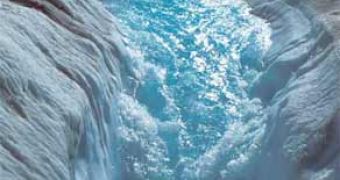It seems that the Arctic ice masses are melting at incredible speeds lately, as this year, scientists recorded the largest quantity of ice melting in history. With the help of measurement made over the last five years, they were able to determine that more than half of the Arctic ice has been melting in the meantime. If we predict the clime evolution of the next four to six years into the future, we might find that, at the end of this period of time, there will be no solid surface in the region where the North Pole is located.
But, this aspect seems to pose some questions about what really triggers such a rapid melting, as global warming does not seem to evolve fast enough to be the only one responsible for the effects. The same situation is available for Greenland, which is relatively close to the Arctic regions. Apparently there is increased geological activity in the area, as scientists have found at least one hot spot under the island, which presented increased water ice melting speed, and more fresh water runnings towards the sea.
Until now, it has generally been believed that the global warming effect is responsible for these consequences, however it seems that nature is bringing a far larger contribution to the global warming effect.
The geological active hot spot is situated somewhere in the northeast corner of the Greenland Ice Sheet, from which heat escapes melting the water ice. Nevertheless, though we might have contributed in a rather small part to this process, by the global warming effect, still this natural occurring phenomena could have disastrous consequences on the environment.
The first evidence of unusual activity was discovered in 1991, when rivers of ice started running through the main body of ice, and drained into the sea. However, scientists have not been able to determine at the time what caused the phenomena, as they were found right in the middle of the ice sheet.
It seems that the new found hot spot in Earth's surface is a result of the thin layer of crust in the general area, which allows heat to escape to the surface, from the magma running closely below the surface of the Earth. Another mystery related to the appearance of the hot spot is related to the fact that such structures do not develop suddenly, but evolve slowly in time.

 14 DAY TRIAL //
14 DAY TRIAL //